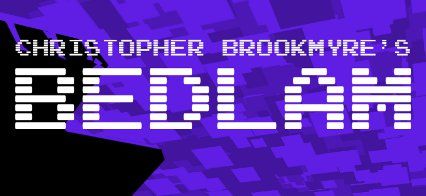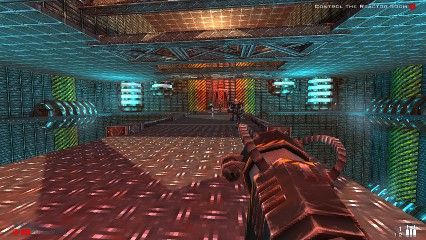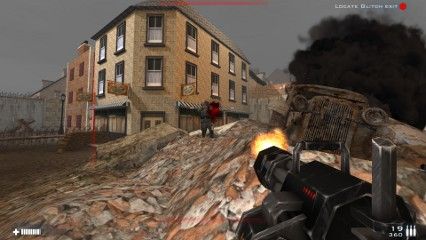
Playing games within games may sound a little too Inception-like for some, but in the case of Bedlam it’s more like a playable history of FPS games. And with lessons to learn like rocket jumping, health bars and gunning down waves of cyborgs, what’s not to like? If the title sounds familiar, you might know of the book of the same title written by British author Christopher Brookmyre.
To put it simply, Bedlam plays like an interactive love letter to first-person shooters of the’80s, ‘90s and early ‘00s. In the early access build we played it took us through a pair of distinct worlds that obviously take inspiration from two of the most popular shooters of the time; Quake and Medal of Honor.
Whilst readers of the book may be familiar with protagonist Ross Baker, the game focusses on Heather Quinn, a programmer at medical scanning developer Neurosphere who finds herself promptly sucked into a rather pixel-y virtual world. The game is played out from her perspective, with out-loud musings to herself providing the narrative. She’s also Scottish and full of sweary gamer-Tourette’s. As such her brief analysis of every bizarre situation encountered is usually quite hilarious and definitely a compelling reason to keep you hooked on the story.
The first game era our plucky Scottish research assistant visits is StarFire, a game she fondly remembers from her childhood that’s packed with enemy marines and Strogg-like doppelgangers. It immediately feels very Quake-ish thanks to its enclosed corridors between open arena-like areas. The level design feels impressively retro in its presentation, well, until you realise that many modern shooters still funnel you down corridors, only they attempt to maintain the illusion of openness. Blasting through these close quarters environments feels great, especially when charging head-on around corners eager to bore a shotgun into the chest of the next alien you find.

Rocket launchers were definitely more fun in the ’90s
Peppered throughout StarFire are wide-open arenas spread across many different levels accessible via a propulsion system that seems sadly MIA in modern shooters; jump pads. Step on one to be flung across an acre in a smooth arch, attempting to line up headshots and score rocket splash damage as you hurtle from one side of the stage to the other. At times it feels like Quake Arena with a touch of Unreal Tournament, all tied together with futuristic blasters that are authentically jagged and polygonal in appearance. From the first 20 minutes or so, you’d be forgiven for thinking Bedlam was just a Quake sequel which preserved the low-res textures and poly count. That is until you stumble through your first glitch.
Throughout the game are glitch-like portals that take you to the ether between game worlds, a Tron-like terrain that exists outside the game space. It acts as a convenient bridge between game worlds and fuels the bonkers storyline with a handy way to instantly change the scenery. It’s also a great location to discover out of context weapons to take between game worlds. I never thought I’d get the opportunity to harpoon a cyborg in the chest plate with a medieval crossbow, but the glitchy void certainly delivered!
Following one such glitch took us to the second sprawling set of game environments, Death or Glory. It strips back the sci-fi corridors and spits you out into the middle of a Nazi occupied town. Things suddenly get very Medal of Honor-y, with streets and buildings chock-full of enemy snipers that brought back haunting memories of Allied Assaults’ unforgiving Sniper Town level. Suddenly, running shotgun first into every enemy was no longer the most strategic manoeuvre to employ…

Rewriting WWII with future bullets
This sudden change in pace seems a little jarring at first, and gave me a couple of death screens to contemplate the sudden change in strategy required. However, from the game-hopping story’s point of view, it demonstrates the subtle differences between games in the same genre beautifully. It’s also lots of fun carrying over weapons from the previous game world. Mowing down waves of Nazis with a futuristic chain gun was very therapeutic after finally dragging my bullet riddled head out of sniper land.
The setting of games within games from over a decade ago does bring up a bit of a conundrum from a critical point of view though. Is bad game design forgivable because it’s an authentic recreation of what was done back then? The rough textures and AI with little sense of preservation for itself can be seen as a fun poke at how things were a few years ago. Frustration cuts in when the game forces you to aimlessly hunt around a level cleared of enemies for a key lost in the mix, which simply isn’t fun, especially as it took me 20 minutes of wandering to find the damn thing. Is a parody of an aged and shoddy game mechanic still an aged and shoddy game mechanic?
It didn’t happen often in the preview levels, but on the couple of occasions where these naff and poorly aged game objectives did crop up, it filled me with a frustration I haven’t felt for almost ten years. However, the majority of the game feels very tongue in cheek, and as it’s still in early access there’s time to make things a little clearer without sacrificing the classic game feeling.
Bedlam still feels like it’s in the early stages (probably why it’s in Steam’s Early Access program, duh), but with a healthy level of activity from the devs at RedBedlum and fairly frequent game updates, it’s obvious there’s still plenty more to come. The £12.99 admission price isn’t bad either, and really treads down most of the grumbles I have at this point. There’s still a lot of work left to make it great, but the two hours of game that’s currently there is genuinely fun for the most part. And with such a novel idea, it’s definitely a refreshing change from the copy and paste shooters that are making the FPS genre staler with every year.


Comments